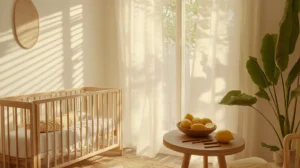Table of Contents
ToggleGive Me 10 Minutes and I’ll Transform How Your Child Sees Their Body Forever
Have you ever caught yourself saying, I look so fat in this, and then noticed your little one gazing up at you, absorbing every word? Or maybe you’ve overheard them say, My tummy is too big, and felt your heart sink, wondering where they learned that from?
Let me tell you something I wish someone had told me before I became a parent. The way we speak about bodies in our homes—especially our own—plants seeds that grow into either forests of self-love or tangled weeds of insecurity for our children.
When my daughter was just four, she pinched her little round belly one bath time and said, I don’t want this anymore. I froze, realizing that somehow, despite my best intentions, she’d already absorbed the message that some body parts were undesirable. That moment changed everything for me.
In this post, I’m going to share with you what I’ve learned since then—the strategies that transformed how my children talk about their bodies, and more importantly, how they feel inside them. Because here’s the truth: raising body-positive children isn’t just about what we say to them—it’s about creating an environment where bodies are respected, not ranked or criticized.
You might be thinking that in today’s world of filtered photos and impossible beauty standards, this seems like swimming against a powerful current. And yes, you’re right—it is. But I promise you, creating a body-positive foundation from day one is not only possible, it’s one of the most powerful gifts you can give your child.
So give me just 10 minutes, and I’ll share how we can break this cycle together, starting today.

The Words We Choose Shape Our Children’s Reality
This may sound unbelievable, but your child’s relationship with their body begins forming before they can even speak. Every time you grimace at your reflection, sigh about needing to lose weight, or celebrate fitting into pre-pregnancy jeans, little ears are listening and learning what bodies mean in your family.
I remember growing up in my grandmother’s home in Trinidad, where bodies were simply vehicles for living life fully. Look at those strong legs that carry you up the mango tree! she would say, or Your round belly shows how well we eat in this house! Bodies weren’t good or bad—they were functional, capable, and worthy of care.
But somewhere along the way, I lost that wisdom. I found myself casually commenting about feeling fat or needing to work off dessert. Until that bath time moment with my daughter made me realize—my words were creating her world.
Here’s what I learned: changing your language isn’t about censoring yourself. It’s about shifting focus from how bodies look to what they can do and how they feel.
Instead of saying, I need to lose weight, try I want to feel stronger when I play with you. Rather than I hate my arms, say I’m grateful my arms can give you big hugs.
The most powerful phrase I’ve added to our family vocabulary is simply: Bodies come in all different sizes and shapes, and all bodies are good bodies. It sounds simple, but repeated consistently, it becomes a foundation your child can stand on when the world tries to tell them otherwise.
The moment you shift how you speak about bodies in your home, you plant seeds of body respect that will grow stronger than any message society can throw at them.

Breaking the Cycle of Food Guilt and Shame
Have you ever felt that the more you try to control your relationship with food, the more complicated it becomes? Maybe you’ve found yourself saying things like I’m being so bad by eating this cake or I’ll need to skip dinner after this ice cream.
Our children are listening, and they’re learning that food isn’t just food—it’s a moral judgment about their worth.
In my family, this hit home when my son refused to eat his favorite coconut sweetbread at his fifth birthday party, whispering to me, Daddy said cake makes you unhealthy. I realized then that in our well-intentioned efforts to encourage healthy eating, we had accidentally created fear around food.
Here’s what works better: neutralizing food language. In our home, we no longer have good or bad foods. We have everyday foods that fuel our bodies and celebration foods that feed our joy. Both have value in different contexts.
When we talk about nutrition, we focus on how foods make us feel: Fruits give us quick energy for playing, or Protein helps build strong muscles. We never link food to weight or appearance.
My grandmother had a saying that I’ve brought back to our family table: Food is love made visible. In the Caribbean tradition I grew up with, meals were about connection, not restriction. Honoring that wisdom means teaching our children that eating is about nourishment and pleasure—never punishment or reward.
Try these small changes:
- Never use food as reward or punishment
- Avoid labeling foods as good or bad
- Don’t comment on how much or little someone is eating
- Talk about how foods make you feel, not how they might change your appearance
- Celebrate cultural food traditions without apology
When we release food from its power to define our worth, we free our children to develop a relationship with eating that serves them for life.

Your Child’s Body Is Not a Project to Be Fixed
Let me share something that changed everything for me. One evening, I was bathing my youngest daughter when she looked up at me and asked, Mommy, when will my legs get pretty? She was just three years old.
That question stopped me cold. Where had she gotten the idea that her perfect little legs weren’t already beautiful? The answer became clear when I reflected on how often she’d heard comments about bodies needing to be improved — not just from me, but from family members, friends, and media.
Here’s what I want you to know: the moment we position any body as a project needing improvement, we teach our children that bodies earn their value through constant work. This creates a lifelong relationship with their physical self based on criticism rather than acceptance.
In my childhood home, my grandmother would say, Your body is not for decoration, it’s for living your purpose. This wisdom got lost in my adult years until I had to relearn it for my children’s sake.
Now, rather than focusing on appearance, we celebrate what bodies can do. Look how high you climbed! instead of You’re looking slimmer. Your arms are so strong for carrying your baby brother, not Your arms are looking toned.
The most powerful question I ask myself before commenting on my child’s appearance is: Am I reinforcing that their body’s purpose is to be looked at, or to live in?
When we stop treating our children’s bodies (or our own) as projects, we give them freedom to experience their physical selves as instruments for experiencing life rather than objects for others’ approval.
Your child came to you perfect. Not perfect as in flawless, but perfect as in complete. Their body is not waiting to become worthy through change. It already is.

Creating a Home Where All Bodies Are Respected
Have you ever noticed how children naturally accept body diversity until they’re taught not to? My son once asked why his friend’s mom had the biggest, squishiest hugs with such pure delight that it reminded me: judgment about body size is learned, not innate.
Creating a home where all bodies are respected means actively countering the messages our children receive elsewhere. It’s about more than just avoiding negative body talk—it’s about celebrating body diversity as natural and beautiful.
In our family, we’ve made these practices non-negotiable:
- We never comment on someone’s weight changes, even as a compliment
- We actively point out body diversity in books, media, and life as a positive thing
- We challenge stereotypes when we see them (People of all sizes can be athletes)
- We respect body boundaries and teach consent from infancy (May I tickle you?)
- We express gratitude for what our bodies do for us, not how they look
One simple practice from my Caribbean upbringing that we’ve incorporated is the morning greeting for our bodies. Each day begins with a moment of gratitude: Thank you, legs, for helping me run. Thank you, hands, for letting me create. This small ritual centers functionality over appearance.
When my daughter came home upset because a classmate was teased about their weight, we talked about how bodies naturally come in different sizes, just like heights or hair colors. We discussed how boring it would be if everyone looked exactly the same.
Creating a body-positive home environment doesn’t mean you’ll never face challenges from the outside world. But it does mean you’re giving your child a safe harbor—a place where their body’s worth is never in question, regardless of its size, shape, ability, or appearance.
The most powerful thing about this approach? Children who grow up in homes where all bodies are respected tend to become adults who extend that same respect to themselves and others—breaking cycles of body shame that may have existed in your family for generations.

When the World Pushes Back: Preparing Your Child for Diet Culture
No matter how body-positive your home environment is, there will come a day when your child encounters diet culture. Maybe it’s a relative commenting on their appetite, a friend talking about getting skinny, or a teacher praising weight loss. These moments can undo our careful work in an instant—unless we’ve prepared our children.
I’ll never forget when my eight-year-old daughter came home from school confused because her friend was skipping lunch to get a thigh gap. Despite all our body-positive talk at home, I hadn’t explicitly given her tools to recognize and reject harmful messages about bodies.
That’s when I realized: creating a body-positive child isn’t just about what we say—it’s about teaching them to critically evaluate what others say too.
We began practicing what I call diet culture detective work—identifying and questioning messages that suggest some bodies are better than others. When we see ads suggesting people need to change their bodies, we ask: Who profits if people feel bad about themselves? When we hear comments about good or bad bodies, we ask: Who decided that? Based on what?
I’ve taught my children these response phrases for when they encounter body criticism:
- In our family, we believe all bodies deserve respect.
- I like my body just as it is.
- Bodies naturally come in different shapes and sizes.
- I care more about how my body feels than how it looks.
- That kind of talk isn’t helpful or kind.
My grandmother used to say, Not everything that falls on your ears deserves a place in your heart. Teaching our children to filter and question body-negative messages is perhaps the most important skill we can give them in today’s image-obsessed world.
Remember: you can’t control the messages your child encounters, but you can give them the tools to interpret those messages critically rather than absorbing them as truth.
The Greatest Gift: Self-Acceptance Starts With You
Here’s the truth that transformed everything for me: my children will never have a healthier relationship with their bodies than I have with mine. They’re watching, always watching, how I treat myself.
This may be the hardest part of raising body-positive children—it requires us to heal our own relationships with our bodies. It means catching ourselves when we criticize our appearance, stopping the habit of weighing ourselves obsessively, challenging our own beliefs about good and bad bodies.
I spent years telling my children their bodies were perfect while secretly hating my own softness after childbirth. The disconnect was obvious—children sense hypocrisy immediately. It wasn’t until I committed to treating my own body with the same respect I wanted them to have for theirs that our family culture truly changed.
This doesn’t mean you have to love every aspect of your appearance. Body positivity isn’t about feeling beautiful all the time—it’s about knowing your worth isn’t determined by your appearance.
Start with small steps. Maybe it’s looking in the mirror and finding one thing to appreciate about your body’s function rather than form. Perhaps it’s buying clothes that fit your current body rather than waiting to deserve them. For me, it was stopping mid-criticism and asking, Would I want my child to speak to themselves this way?
In my grandmother’s wisdom from back home, she would say, Your body carries your spirit through this world—treat it with the respect due to such important work. When I remember this, it becomes easier to model the self-respect I hope to see in my children.
The most powerful gift you can give your children isn’t perfect advice—it’s watching you practice what you preach. When they see you accept your body, they learn it’s possible to accept theirs.
Because at the end of the day, when you embrace your body as worthy of respect regardless of its size, shape, or appearance, you show your child how to do the same. And that lesson will carry them through challenges no amount of careful words alone could prepare them for.
So if you take just one thing from everything I’ve shared today, let it be this: your journey toward body peace isn’t separate from your parenting—it’s central to it. The healing you do for yourself becomes the foundation your children build their lives upon.
I believe in you. I believe in the power of breaking these cycles. And I know that your children will carry the body respect you teach them not just through their childhood, but into the next generation.
Thank you for being here. For wanting better for your children. And for being brave enough to consider that the path might begin with being kinder to yourself first.
Step into Sue Brown's World of Baby Care, where you'll find a treasure trove of knowledge and wisdom waiting to be explored. Sue's dedication to providing accurate and up-to-date information on baby care shines through in every article, blog post, and resource she shares. From newborn essentials to sleep training tips, breastfeeding advice to nurturing your baby's development, Sue covers a wide range of topics that are essential for every parent to know. Her warm and compassionate approach creates a sense of community and reassurance, making her website a safe haven for parents seeking guidance and support. Let Sue Brown be your partner in this beautiful journey of parenthood, as she empowers you to create a loving, nurturing, and thriving environment for your little one.
- Indoor Air Quality for Infant Respiratory Health - October 20, 2025
- Positive Discipline Foundations: Setting the Stage From Infancy - October 18, 2025
- 2025’s Most Innovative Baby Products Worth the Investment - October 16, 2025



